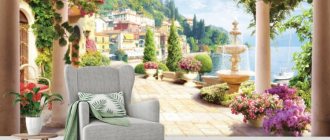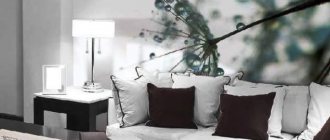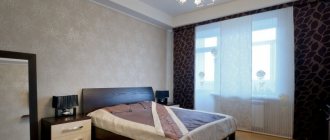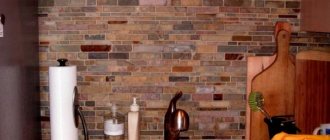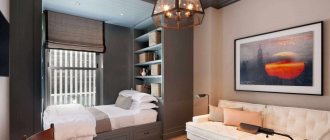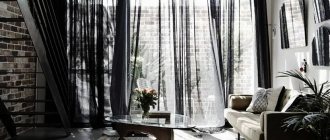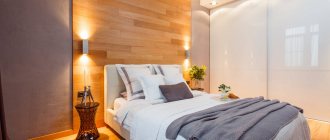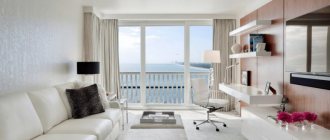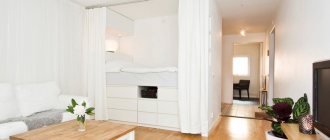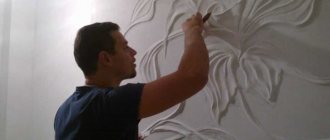In the photos of living room interiors, the frescoes look very impressive. This decorative element not only fits into any design, thanks to the richness of images and colors, but also gives the living room individuality. Paintings are traditionally used to decorate walls, niches and ceilings, but the fresco will look no less interesting on the floor. The painting attracts all the attention of guests and often becomes the central element of the interior, to which everything else is matched.
Classic and modern frescoes
The first frescoes date back to the 2nd century BC. Wall painting of this kind was widespread in Ancient Greece and Ancient Rome, as well as in Ancient Rus'. The word “fresco” itself is of Italian origin. "Fresco" means "fresh". This translation contains the secret of the technique of creating frescoes.
The original frescoes were applied to fresh, damp plaster. This was not at all the plaster that is used to decorate apartments today - a special mixture of sand and slaked lime was used. Paints were prepared from natural pigments and diluted with water. A pattern was created on freshly applied plaster. When dry, the paints literally fused with the base, providing the fresco with phenomenal durability.
Sample of an ancient fresco
The lime dried quickly, so the craftsmen applied it in fragments. It was impossible to correct the drawing. If something went wrong, you had to completely remove the dried lime and start all over again. Those ancient frescoes that we see when visiting temples, cathedrals and palace complexes are the result of long and painstaking work by professional craftsmen.
There is also a technique for applying paints to dry plaster (“a secco”). The finished image is inferior to classical frescoes only in terms of durability.
Today, many other ways to create frescoes have been found. And by the fresco itself we now mean any wall and ceiling painting with paints applied with a brush, airbrush or other method. According to the technology of creation, these are not the well-known classical frescoes, but in appearance such modernized panels are very similar to ancient masterpieces.
To decorate a room with a fresco, you don’t have to be a painter. You won’t have to hire a craftsman either – there are plenty of imitations of frescoes on sale. They are made using different technologies, the design can be anything. The price varies depending on the method of creation: there are extremely affordable options, and there are also more expensive analogues.
Frescoes are now used to decorate not only plastered walls. Such images fit well into almost any interior style , perform a decorative function, and can visually expand the space and zone it.
Modern frescoes are made mainly from natural materials. The technologies used make it possible to protect the image from the harmful effects of moisture, ultraviolet radiation and temperature changes. Some designers even use frescoes to decorate the facades of houses.
Design features
Fresco is a technique of painting on wet or dry plaster using paints and brushes. In the Middle Ages and the Renaissance, the method of painting only on wet plaster was used, which, after drying, formed a film, which made the fresco durable. Today, a fresco in the interior is called any wall painting using paints, brushes and an airbrush, which makes installation work easier.
In a modern interior you can find a fresco in different techniques and with different patterns, which can be applied not only to plaster, but also to another base. This design option is suitable for a classic interior, where all the canons of decoration and furniture are observed, as well as for modern design.
Main types of frescoes
The classical technology of creating frescoes for home decoration is rarely used. Instead, they usually use ready-made frescoes, which are quite easy to install, but in appearance are almost no different from their ancient counterpart.
Fresco on elastic plaster
This method is closest to the classic version of creating frescoes . Instead of a mixture of lime and sand, special plaster compositions are used as a base. Components are introduced into them that allow the plaster to remain damp and elastic longer, which gives the master more convenience in creating a design. The plaster is strengthened using a mounting mesh.
The result is a handmade fresco. The result depends on the talent of the artist, but the result is still a unique picture. Such frescoes are expensive, they are not created very quickly, but in appearance they are as close as possible to the original samples.
Fresco on canvas
Each fresco is individual. The artist uses a canvas, primes it, applies plaster, and then creates a design and ages it, creating cracks and abrasions. Only natural paints are used in the work. Such frescoes turn out to be quite fragile, they are afraid of detergents. For additional protection from external influences, the fresco is coated with wax.
The work on creating these frescoes is labor-intensive. Each image is unique. The products are quite expensive and belong to the elite segment. The fresco can be framed or without. The product without a frame can be carefully glued to the wall using wallpaper glue, resulting in an effective imitation of a real fresco.
Fresco based on plaster
Another worthy imitation of real ancient frescoes. The design is applied to a layer of elastic plaster, which is reinforced with a mounting mesh. The image is not created by hand, but looks very much like handmade. The finished factory fresco is mounted on a wall or ceiling with glue, the edges are treated with plaster, thereby achieving the effect as if the design was applied directly to the wall.
This imitation of a fresco is quite popular today. Its main advantages include low cost and excellent performance. The product is not afraid of sunlight and moisture, and does not crack, as it is reinforced with mesh. Moreover, the texture is preserved, as in ancient frescoes.
Fresco on non-woven base
These products boast affordable prices. As the name suggests, non-woven fabric plays a dominant role here. A thin layer of plaster is applied to the base, and the design is created, as a rule, using a photo wallpaper printer. Then the image is artificially aged, if necessary. Thin cracks form a whole mesh throughout the fresco, giving the image the effect of antiquity. However, it is often possible to do without such an option. The fresco can also be coated with special impregnations.
Wallpaper-frescoes are attached to the surface using glue for non-woven wallpaper. Small irregularities on the base are allowed - they will hide under the coating. Even an untrained master can handle the installation of such frescoes. The product can be used to decorate the entire wall or part of it. The joints between the individual canvases will be invisible, but in urban apartments one canvas is often enough.
Frescoes on non-woven fabric are stamped in large quantities. There is no need to talk about an individual design, but the products are inexpensive and allow you to breathe a special mood into your home.
Fresco on a self-adhesive basis
Self-adhesive frescoes belong to the budget segment; their installation principle resembles photo wallpaper. Some designers generally consider them to be a type of photo wallpaper, since the external resemblance to them is much greater than the resemblance to classical frescoes.
The product is based on a self-adhesive fabric. The reverse side is treated with a special compound. It is enough to remove the protective film to glue the fresco to the wall - no additional solutions are needed. A special composition containing river sand is applied to the front side. Using digital technology, he creates the necessary pattern on it. It cannot be aged, but there is a slight relief.
Among the main advantages of such frescoes, we note their low cost, ease of installation and a huge selection of designs. On the other hand, the product is quite thin, the layer of plaster with sand is minimal, so the surface of the wall must be ideal - all the cracks and pits will be noticeable, and such a relief will only spoil the overall picture.
Fresco on a rigid base
The plaster is applied to a wooden or ceramic base, less often – a plastic one. The drawing is usually created using acrylic paints. If an aging effect is required, all chips and abrasions are created on the base. The big advantage of this method is the ability to make chips along the edges. It feels like the fresco was cut out of an ancient building and moved into your apartment.
The frescoes turn out to be quite heavy, so it will not be possible to cover a large area with them. It is not possible to find a product larger than 3 * 1.5 m, but even fairly compact works cost a decent amount. As a rule, frescoes of this kind are mounted on walls like paintings, but some prefer to glue them to the surface. Someone manages to frame the product. It all depends on what goals you plan to achieve.
Performance techniques
Unlike earlier times, today's technology offers a large selection of frescoes created in various ways. In addition to manual work, paintings are applied with digital printers and other special equipment. The bases for application are also varied. Naturally, the choice of material and execution technique directly affects the cost of the fresco, so it is quite possible to decorate your home with both an expensive and a more affordable piece.
Fresco on elastic plaster
Painting frescoes on walls on plaster is the ancestor of all modern technologies. This technique has been known since ancient times and remains relevant to this day. Its essence lies in the fact that wet plaster is applied to the surface of the wall, on which a pattern is formed. Since the material dries very quickly, all work to create a masterpiece must be carried out quickly. The picture is painted with paints that are absorbed quite deeply. At the same time, the image has a stylish matte surface without reflections and can retain its original appearance for centuries. This method of creating a fresco advantageously hides any imperfections in the walls and looks great from anywhere in the room.
Fresco on canvas
A wall fresco made on canvas is a handmade work that is by no means cheap. The technology consists of applying a special composition to the canvas, on which an image is formed using natural pigments. Real masters are able to make a real work out of a painting, artificially aging it by adding cracks and roughness. Depending on the size, paintings are sold in rolls or on stretchers and mounted to the wall using glue. The disadvantage of fresco on canvas is its reduced moisture resistance, so it cannot be washed. To ensure that the painting retains its original freshness for a long time, it is often coated with wax.
Wall frescoes on non-woven fabric
Such frescoes can be called the most economical option for large areas. In terms of external characteristics, they are not inferior to paintings created on canvas, but their cost is much less. A large fresco consists of separate canvases onto which images are applied using a special printer. The fragments are attached to the wall or ceiling surface with glue intended for this type of wallpaper, while maintaining the integrity of the picture, since the seams are completely invisible.
Fresco on self-adhesive canvas
The fresco on a self-adhesive basis is very similar to textured wallpaper. The role of limestone in this case is played by a paste based on river sand, onto which the painting is digitally applied. The finished canvas is glued to the wall and has a flawless appearance only if the surface is absolutely flat. A self-adhesive fresco is quite thin, so if there are bumps and irregularities on the surface of the wall or ceiling, they will definitely show through and the painting will lose its attractiveness. This technique is appropriate in modern interiors, since it is impossible to artificially age it.
Fresco on a rigid base
The fresco can also be made on a rigid base. In terms of appearance, it is in no way inferior to canvas works, but weighs much more. Such paintings are usually made in a small format.
Craquelure
Frescoes made using the craquelure technique are perfect for antique-style interiors. The works are made using decorative plaster, which includes marble chips. Thanks to this component, an imitation of small cracks is formed in the finished painting, which looks quite stylish in antique interiors.
Design and image
Anything can be depicted on a fresco. The choice for those wishing to use such decor is enormous. In order not to get confused, focus on the style and color scheme of the room. Also take into account the functions that are assigned to the fresco: just decoration, an accent detail, zoning, or also a way to compensate for some shortcomings (low ceilings, small area, lack of lighting, etc.).
Frescoes on the following subjects are especially popular :
- reproductions of famous paintings are an option for a classic interior. The images of saints are also sometimes used;
- an antique or medieval plot will also complement the classic interior and allow you to convey the true character of fresco art;
- patterns and abstract drawings are an option for modern interiors. Can decorate an entire wall;
- sea, forest, mountain and field landscapes add additional space to the apartment and are suitable for a range of interiors;
- floral ornaments fill the apartment with warmth, especially suitable for classic interiors and Provence;
- city landscapes, be it narrow winding European streets with cozy cafes, or skyscrapers of a metropolis, as well as natural landscapes, expand the space of the room. Depending on what kind of atmosphere needs to be created, cozy or driving, choose the appropriate pattern;
- imitation of the view from a balcony or window works great to visually increase the space;
- If you want to decorate the ceiling with a fresco, you can choose images of the sky, birds or angels.
Subjects for frescoes on the wall
The theme of the fresco on the wall plays an important role in interior design. If initially the paintings were images of ancient heroes, scenes from the Bible, historical panoramas, today the choice of subjects is much more diverse. Among the most common are the following:
Landscapes can easily be called the most popular images, since pictures of nature fit perfectly into any interior style. For recreation areas, as a rule, pictures depicting fields and ponds are chosen, as they promote relaxation. A landscape wall mural can be given as a gift;
Still lifes are a good option for kitchens, living rooms or combined layouts. For interiors decorated with elements of luxury, you can purchase a still life fresco that depicts items of antique tableware, for example, jugs, bowls, goblets, etc.;
Portraits are less common, but they can bring some inspiration to the interior if you install a fresco portrait, for example, of an emperor in your study. For the living room, you can choose a simpler format that reflects a cheerful company
In general, when purchasing such a fresco, it is necessary to pay special attention to the emotional state of the person depicted in the portrait;
Abstractions are typical for interiors decorated in modern styles.
There is no plot here, the main importance is given to color, so it is important that it does not cause unpleasant emotions
It is important to pay attention to the fact that blue and green tones help relieve emotional stress, while red can provoke aggression. Often, abstraction frescoes on the wall act as an accent element;
Ornaments can perfectly decorate a room without attracting too much attention. Intricate patterns are inherent in interiors decorated in ethnic styles, as well as in strict styles.
Place and role in the interior
Frescoes in the interior are usually placed:
- on the walls. This is the most popular decoration method. The image can be of any size and shape, occupy a small part of the wall or even the entire wall;
- on the ceiling. This type of placement of a fresco is only suitable for apartments with high ceilings, otherwise the image can be very oppressive. In classic interiors, frescoes are in perfect harmony with stucco;
- for decorating various architectural details, for example, niches, ledges, columns. With the right selection of images you can achieve incredible effects. For example, when depicting open doors of a balcony overlooking the sea in a niche, you can create the feeling that the apartment is, in fact, located on the shore.
Of course, the main role of frescoes in the interior is decor . They bring a certain mood to the room, set the character, and reflect the tastes of the owner. At the same time, such images can also take on other functions:
- zoning _ You can decorate only part of the wall with a fresco, separating one zone from another. Let's say the walls in the combined kitchen-living room are plastered. One of the walls in the living room can be decorated with a fresco. And then certainly no walls will be needed to draw a line between different zones;
- compensation for deficiencies in the premises . By choosing a suitable image of the required color scheme and size, you can change the perception of the room, for example, visually enlarge it, make it lighter or taller.
For low rooms, you can choose a pattern with characteristic vertical lines. This could be an image of a forest, tall buildings, flower stems, etc. These murals work in much the same way as striped wallpaper. You can visually raise the ceilings using images of stone vaults, skies, and bridges. Owners of low-rise dwellings can use another trick. Let the fresco flow smoothly from the wall to the ceiling. This method works flawlessly.
If the room cannot boast the desired area , then it is better to use frescoes in light colors. Images with perspective are perfect: forest paths, city streets, landscapes, etc. To create a harmonious space, the image on the fresco must be supported by interior items. Bright frescoes and images with large designs are not suitable for small spaces.
For rooms with insufficient natural light, choose frescoes in warm colors. Yellow and orange tones work best.
Decoration of architectural forms
With the help of decorative frescoes you can interestingly decorate country houses. Some owners gravitate toward elaborate architectural forms in antique style. Decorating columns with an ancient image can introduce that very element of exclusivity that is missing in standard projects. An interesting finishing option can also be considered the use of frescoes in specially equipped niches. The general mood is emphasized by single accessories from the same time as the subject in the image. A decorative vase coupled with a thematic picture will captivate any guest.
Combination of frescoes with finishing materials
The classic method involves applying frescoes to plaster . Indeed, such images look most harmonious on a plastered surface. Both relief plaster and smooth Venetian plaster are suitable. It is desirable that the tonality of the fresco and the surface match.
In modern realities, frescoes are applied, or rather, mounted on other surfaces. They look good on matte paint, stone, brick and wallpaper. If you choose wallpaper as a basis, then take plain canvases. An abundance of designs and ornaments will distract from the main thing, distract attention and, frankly, hint at the bad taste of the owners.
A short summary
Painting a fresco is an ancient and beautiful way of decorating walls. If you want the entire application process to be done by a professional artist, then you will have to pay a considerable amount of money.
But there is also a cheap option - frescoes, like wallpaper. Any of these options will add a unique touch to your living room.
Still, choose a subject for a fresco with caution and rely on personal preferences. This will help you create real coziness and comfort in your living room.
Fresco and interior style
The fresco can be called an almost universal decoration . Of course, such decor looks best in classic interiors, but with the right selection of patterns and colors, you can successfully fit the fresco into any style:
- in minimalism, a fresco with an abstract design, an image of some laconic object, with stains or color transitions will look great. No complex drawings, ancient scenes or landscapes;
- The frescoes look great in Provence style. In this case, images of lavender fields, grapes, the sea, cozy French streets with cafes are suitable;
- The Mediterranean-style interior will be decorated with frescoes depicting the sea, typical fruits and plants. You can also use a technique with open sashes of windows or balcony doors that offer views of the sea and mountains;
- the oriental interior can be decorated with images of characteristic animals, plants, temples and typical houses;
- Frescoes depicting fields, fruits and berries will fit into a rustic interior; they can be framed with stone;
- classical interior , as well as interior in Rococo, Baroque and Gothic style, can be supplemented with frescoes with reproductions of famous paintings of the Renaissance, scenes from the life of bygone eras. Floral motifs and still lifes are also used. The color scheme should be neutral. If desired, the fresco can be framed with a white or gold frame;
- African style can be decorated with frescoes depicting savannas, wild animals, authentic dishes, and girls. Characteristic patterns also look great;
- It is difficult to fit a fresco into a high-tech style; images that are more reminiscent of photo wallpaper will do. Preference is given to monochrome city landscapes, images of tunnels, bridges and other achievements of human thought. The picture should be as simple as possible;
- with a loft everything is also complicated, but if you really want to use a fresco, then you can settle on a graffiti image;
- An Art Nouveau interior can be decorated with abstraction, for example, with the image of concentric circles, smooth lines and waves.
Modern technologies make it possible to add a fresco to the interior even after the renovation is completed, for example, when you want to freshen up the decor a little. Designers advise deciding on the image and its size before the renovation. This will make it much easier to correctly fit the fresco into the interior.
In the hall
Here designers gravitate toward abstraction. The hallway area is not a place where you need to linger for a long time to look at something. However, the appearance of a colorful fresco on the wall allows you to instantly assess the taste of the owners. Therefore, the selection of application technology is based on these postulates. First quality, then compliance with the color scheme and interior style of the corridor. And the genre and plot come later.
Fresco in the interior of various rooms
And again to the question of universality. Frescoes can be used in all rooms of the apartment - you just need to find the right type, and, of course, decide on the design.
Fresco in the kitchen interior
It is best to place the mural in the dining area. Modern and classic frescoes are resistant to various external factors, but exposing them to increased risk and placing them near a sink or stove is barbaric.
Still lifes, flower arrangements, natural and city landscapes, as well as images of cities are great for the kitchen. For small spaces, use frescoes with perspective: a wheat or flower field, a winding street going into the distance, a forest path, a window overlooking the sea, etc.
The fresco can occupy the entire wall near the dining table, decorate only part of it, or occupy two adjacent walls. Naturally, the picture must correspond to the chosen interior style and color scheme.
Fresco in the interior of the living room
A fresco is the best way to emphasize the status of the main room. If possible, you can allocate an entire wall for the image. The living room is the most suitable room to use a reproduction of a famous painting. True, such a solution will fit most successfully into classic interiors.
A win-win option is landscape . What kind of landscape, sea, mountain, forest or tropical, depends on the style of the room and your preferences. Landscapes are also good because, as a rule, they have a perspective that adds space and freedom to the room. For a living room combined with a kitchen, you can use still lifes . Look at the paintings of the old masters, who depicted fruits, wine, game, and flowers in very naturalistic ways.
You might want to put a portrait of a famous person on your wall, such as a historical figure from a certain era or a creative person who inspires you. Alternatively, you can use your portrait or an image of a loved one.
Ornaments and abstractions look good on the walls of the living room . The ornament can be absolutely anything: such an image will unobtrusively bring the right mood to the room. Abstraction can no longer be called unobtrusive. Here the emphasis will be either on lines or color. The choice of image must be treated very carefully.
The high living room can be decorated with a ceiling fresco. An image of clouds would be perfect.
Fresco in the bedroom interior
Frescoes in the bedroom are often placed above the head of the bed, but other options are also allowed. For a relaxation room, images made in soothing pastel colors are suitable. Beautiful natural landscapes, flowers, clouds, etc. will fit perfectly. It is undesirable to use bright shades and complex drawings with an abundance of details, so it is better to avoid portraits and detailed scenes.
Fresco in the interior of a nursery
It is better to place the image near the bed, and so that the baby, falling asleep, can look at the picture. It calms you down and develops your imagination at the same time. As an image, it is better to take a plot from a fairy tale, a nice natural landscape, or cartoon characters. The picture should be moderately bright: the baby should not get bored looking at it, but the image should not irritate the nervous system.
Fresco in the interior of the hallway
For hallways, which are usually dark small rooms, light frescoes are suitable. A long narrow corridor can be decorated with a colonnade overlooking the sea. An image of a window or balcony with a view from it is also suitable.
In the living room
The most common option for arranging a fresco involves placing it in the living room. This is often expressed in classical subjects and reproductions of masterpieces of the iconic Renaissance era. The style of such a powerful work in its artistic content favorably emphasizes the status of the main room in the house. The front room becomes the calling card of the owners. Scenes with elements of Eastern life are also welcome. However, lately the industrial landscape and everything that can be connected with it have come into fashion. For example, subway tunnels act as a contrast to the fresco technique itself. The compromise option for everyone seems to be the use of seascapes and rural pastorals.
Creating a fresco with your own hands
Creating a fresco by hand
This is an option for those who know how to draw at least a little, or are ready to suffer a little and use a stencil with which you can transfer almost any design to the wall. The sequence of actions is as follows:
- surface preparation. The old coating is removed; if there are uneven areas, plaster or putty is used. Then the surface is primed and a finishing layer of putty or plaster is applied. After re-priming, the wall is ready for painting;
- At this stage, you should know exactly what size the fresco will be and what will be depicted on it. The contours of the future image can be outlined with a pencil or masking tape;
- Acrylic paints are best suited for creating a picture. Even if you are confident in your abilities, you need to make a sketch of the future image in advance. This way it will be clear whether all its parts are located as intended. Designers recommend starting from the top of the fresco so as not to stain or spoil the finished parts. Some experts advise creating large details first, and then drawing small ones;
- If you don’t have the talent of an artist, then you shouldn’t be upset. Even in this case, you can create a fresco with your own hands. Let it be an abstraction that is fashionable today. I don’t want to criticize modern art, but probably anyone can draw a set of lines, shapes and colored spots. For those who don’t like abstractions, there is an option with a stencil . There are stencils made of thin paper. It is glued to the wall, and when it has dried, you can start painting the finished contours. There are slate stencils. Take any image of the required format, draw an outline with a wide stylus and apply it to the wall. An image will be printed on it, albeit in a mirror image, so keep this in mind;
- To age the image, you can apply craquelure to the dried paint. You can apply gold or silver powder to the slightly hardened paint - they will give the image an antique effect;
- When the paints have dried, you can take a washcloth and carefully walk over the entire fresco, removing excess. The top of the image is varnished; several layers of it can be used.
Self-installation of frescoes
Only an artist can create real frescoes. But if you do not have such a talent, but really want to decorate the walls with a stylish image, then modern materials will allow you to do this. We purchase the painting we like on a non-woven base, special glue and begin work.
If the selected fresco has one canvas, then you need to do the following:
- Prepare the wall for wallpaper. To do this, level it and apply a primer. Before pasting, you should close the doors and windows.
- Apply glue to the back side of the non-woven fabrics and carefully treat the walls with it.
- Carefully attach the image to the wall and smooth it to remove glue and air trapped under the canvas.
If the fresco consists of several canvases, then it is glued to the wall in the above manner, taking into account the following actions:
- First you need to assemble all the elements of the image on the floor so that during gluing you do not confuse the individual parts;
- All parts of the drawing have serial numbers, you need to start working with part number one;
- Glue adjacent panels end-to-end, just make sure that the details of the design match perfectly.
Self-adhesive murals are even easier to apply. It will be enough to carefully remove the adhesive layer and press the canvas tightly against the wall, simultaneously removing air bubbles.
